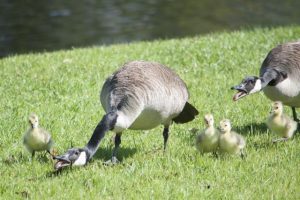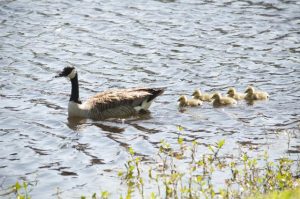Photo gallery by Morgan Purvis
Canadian geese and their newly hatched goslings run a-fowl on campus. They can be seen sitting in the shade, snacking on grass and generally disobeying pedestrian order with their inability to adapt to our cultural norms.
If you are experiencing wildlife xenophobia on campus, you may want take a minute to breathe into a paper bag before reading these next words: they are here to stay. As it turns out these darn geese may have been lying about their Floridian vacations and have actually taken up residence.
UNF Environmental Health and Safety Coordinator Tod McVey told Spinnaker many of the geese on campus don’t migrate at all.

Photo by Morgan Purvis
“They were introduced into the area back in the early 1980s,” McVey said. “ While they are migratory birds, they have essentially grown and populated here and [now] never leave.”
McVey said the retention ponds and flat, mowed lawns where geese can graze peacefully (without predators) make areas like UNF’s campus a prime habitat for Canadian geese. But other than cleaning up their feces, little is done about them on campus. McVey said the overall attitude about the geese is hands-off.
“They are federally protected,” he said.
This means it is illegal to purposely injure, damage or move their eggs or nest without a permit. Simply put, it’s probably a good idea not to mess with them — especially the goslings.
McVey said much of the problems the geese have is people wanting to help them somehow, particularly the goslings.
“About a year ago, somebody put chunks of bread in a nest, thinking that once the babies hatched they would have something to eat. The sad part is that because of the bread, the mother would not come back to the nest,” he said.
UNF psychology professor Dr. Tracy Packiam Alloway said people are attracted to baby animals because of two evolutionary traits.

Photo by Morgan Purvis
“First,” Alloway said, “there is a protective mechanism for things that seem helpless. Maybe when it comes to geese, one is trailing or is unusual and that activates the protective mechanism and we think ‘aw that’s cute.’” This comes from a biological need to protect our own children. The other, she said, has to do with animals’ furry or fuzzy appearance.
“Hair is more attractive, it is a better trait in being attractive [in people] and that works with animals as well,” Alloway said. It is generally why people think puppies are adorable and “may think a hairless cat is pretty ugly.”
Rather than attempting to protect goslings, people may want to be concerned about protecting themselves from the gosling’s parents. McVey said the geese will fight back if they feel threatened.
“We’ve had situations with people who are curious about the babies or the eggs and they have gotten chased off by the geese,” McVey said. “ Just because they look goofy and [seem like] they are an easy target, they can be very aggressive.”
Although the geese seem to be more quack then bite, they will nip at those whom they consider intruders. If they do attack, Ohio Goose Control lists on its website to maintain eye contact while slowly backing away. Stay neutral in demeanor and do not turn your back to them.
Goslings are certainly adorable, but interfere with nature and you may be the receiving end of a lunging beak. It may be best to just leave them alone and goggle at them from a distance.
Video by Jack Drain
—
For more information or news tips, contact featureswriter@unfspinnaker.com; if you see an error in this story or have any compliments or concerns, contact features@unfspinnaker.com.







